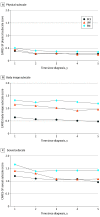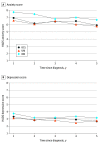Association of Breast Cancer Surgery With Quality of Life and Psychosocial Well-being in Young Breast Cancer Survivors
- PMID: 32936216
- PMCID: PMC7495332
- DOI: 10.1001/jamasurg.2020.3325
Association of Breast Cancer Surgery With Quality of Life and Psychosocial Well-being in Young Breast Cancer Survivors
Abstract
Importance: Young women with breast cancer are increasingly choosing bilateral mastectomy (BM), yet little is known about short-term and long-term physical and psychosocial well-being following surgery in this population.
Objective: To evaluate the differential associations of surgery with quality of life (QOL) and psychosocial outcomes from 1 to 5 years following diagnosis.
Design, setting, and participants: Cohort study.
Setting: Multicenter, including academic and community hospitals in North America.
Participants: Women age ≤40 when diagnosed with Stage 0-3 with unilateral breast cancer between 2006 and 2016 who had surgery and completed QOL and psychosocial assessments.
Exposures (for observational studies): Primary breast surgery including breast-conserving surgery (BCS), unilateral mastectomy (UM), and BM.
Main outcomes and measures: Physical functioning, body image, sexual health, anxiety and depressive symptoms were assessed in follow-up.
Results: Of 826 women, mean age at diagnosis was 36.1 years; most women were White non-Hispanic (86.7%). Regarding surgery, 45% had BM, 31% BCS, and 24% UM. Of women who had BM/UM, 84% had reconstruction. While physical functioning, sexuality, and body image improved over time, sexuality and body image were consistently worse (higher adjusted mean scores) among women who had BM vs BCS (body image: year 1, 1.32 vs 0.64; P < .001; year 5, 1.19 vs 0.48; P < .001; sexuality: year 1, 1.66 vs 1.20, P < .001; year 5, 1.43 vs 0.96; P < .001) or UM (body image: year 1, 1.32 vs 1.15; P = .06; year 5, 1.19 vs 0.96; P = .02; sexuality: year 1, 1.66 vs 1.41; P = .02; year 5, 1.43 vs 1.09; P = .002). Anxiety improved across groups, but adjusted mean scores remained higher among women who had BM vs BCS/UM at 1 year (BM, 7.75 vs BCS, 6.94; P = .005; BM, 7.75 vs UM, 6.58; P = .005), 2 years (BM, 7.47 vs BCS, 6.18; P < .001; BM, 7.47 vs UM, 6.07; P < .001) and 5 years (BM, 6.67 vs BCS, 5.91; P = .05; BM, 6.67 vs UM, 5.79; P = .05). There were minimal between-group differences in depression levels in follow-up.
Conclusions and relevance: While QOL improves over time, young breast cancer survivors who undergo more extensive surgery have worse body image, sexual health, and anxiety compared with women undergoing less extensive surgery. Ensuring young women are aware of the short-term and long-term effects of surgery and receive support when making surgical decisions is warranted.
Conflict of interest statement
Figures


References
-
- Nash R, Goodman M, Lin CC, et al. . State variation in the receipt of a contralateral prophylactic mastectomy among women who received a diagnosis of invasive unilateral early-stage breast cancer in the United States, 2004-2012. JAMA Surg. 2017;152(7):648-657. doi:10.1001/jamasurg.2017.0115 - DOI - PMC - PubMed

